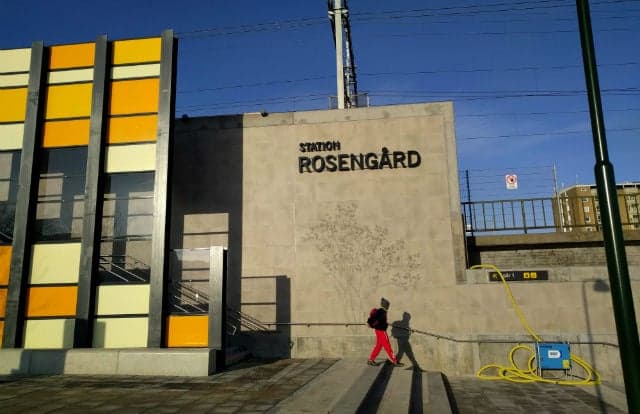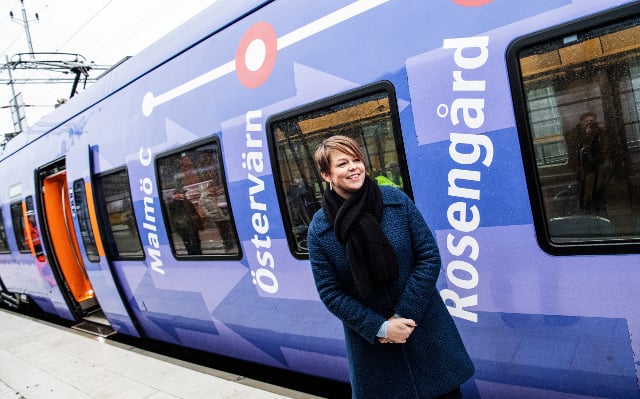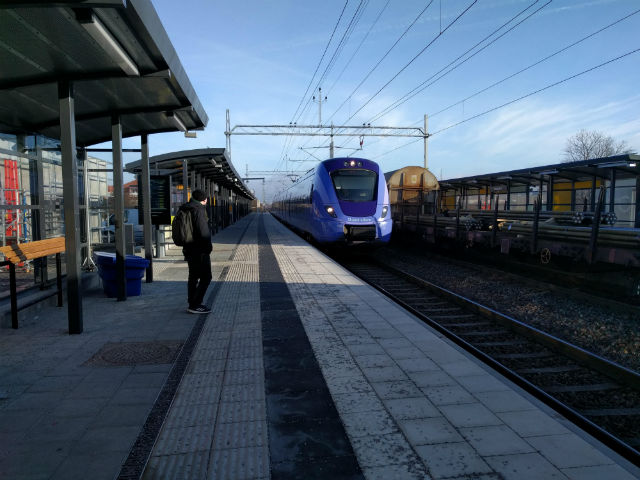Ring to bind: Will Malmö's new rail line fight segregation?

When Malmö mayor Katrin Stjernfeldt Jammeh and a group of local politicians stepped off a specially chartered train in the troubled district of Rosengård in December, she made big claims for the new ring line she was launching.
"This inauguration is about much more than commuting by the Pågatåg [a regional train]," she said. "This is about developing a city to which all Malmöites have access."
The 155 million kronor ($16m) line, she said, would "bind Malmö together", linking the somewhat deprived districts of Östervärn, Rosengård and Persborg to the Central Station in one direction, and to the out-of-town shopping areas of Svågertorp and Hyllie in the other.
The track has long been something which splits the city in two, marking the dividing line between Rosengård, a troubled district with a high immigrant population, and the rapidly gentrifying districts of Sofielund and Sorgenfri.
By bringing passenger traffic back to the freight line and putting up noise barriers along the track, the hope is to change that.
More than two months later though, Rosengård Station is operating but more-or-less deserted, while the station itself is still a building site, with the planned trees and bushes outside yet to be completed. No one I speak to in the next-door Törnrosen housing estate, touted as the main beneficiaries, say they use the new train line.
"Right now there's not that many people on the train, very very few, especially at this station," says Erik, who is the only person waiting at the station when I arrive. "It is faster if the train is on time. The problem is that train hardly ever is on time."
By the time a train arrives on the other platform ten minutes later, there are a handful of others waiting.
Only a handful of passengers got on the train at the new Rosengård Station when The Local visited. Photo: Richard Orange
Jasmin, 30, who lives in Rosengård, is on her way to Hyllie, where she works at a bank. "It is easier for me than to take the bus, I think it saves 10-15 minutes," she says.
But she doesn't expect the line to reduce segregation or make much difference to Rosengård's reputation as one of the city's most deprived districts: "Just because you have a new station doesn't mean you will have another image of Rosengård."
None of this comes as a surprise to Christer Larsson, Malmö's Director of City Planning, however, even though he still sees the line as a central part of his strategy for the city's development.
"It's opened very recently so it hasn't yet become a part of the pattern of people's movements. People have to understand it and start to use it," he tells The Local.
"It was a great day, because we have struggled for this project for 20 years now," he said of the opening in December.

Malmö mayor Katrin Stjernfeldt Jammeh opening the new station in December 2018. Photo: Johan Nilsson/TT
Malmö plans to use the reopened station of Östervärn as the centre of a new residential area, with up to 5,000 houses and seven new schools. The station at Rosengård, meanwhile, will form the centre of Admiralsstaden, with new buildings planned filling in spaces between the Törnrosen apartment blocks, and even perhaps a high-rise apartment building called Culture Casbah.
"It's a mobility project, it's a social project and it's also part of a bigger strategy," Larsson explains. "Our idea is to combine this ring with other investments in cultural buildings and welfare buildings, so you will have a destination close to the railway station."
He is confident that as these projects are established, the line will become one of Malmö's most important transport links.
RECOMMENDED READING:
-
What's behind rising inequality in Sweden's schools, and can it be fixed?
-
What lessons can Sweden learn from its Yugoslavian refugees?
-
No-go zone? How one of Sweden's roughest areas edged out its drug gangs
As the train trundles past the residential area of Persborg, houses slowly give way to industrial areas and then to fields, skirting round the city's outer edge before stopping off at the out of town shopping centre of Svågertorp, and then, once again through fields on the way to Hyllie.
It's easy to see how the opening of the line will create new areas for residential and industrial development.
In December 2020, Larsson says, the city plans to reopen the rail link to the seaside suburb of Lomma, which was closed down to passenger traffic in 1983, and link it to the Malmö ring. There are also plans to link the ring directly to Lund.
But this is not the direct link craved by those on board on the day I travel.
Isra, a 23-year-old from Rosengård, tells me what she would most like is for the train to go directly from Rosengård to Copenhagen, where she is studying to be a nurse.
"If it went to Copenhagen it would be really, really good, because a lot of people in Rosengård work in Copenhagen," she tells me. "People who come to Sweden because they get married and can't bring their wives to Denmark."
Daabas Mahmoud, who gets on at Persborg, seconds this, adding that it would help him if the first trains started earlier than 6am, so that he could make his commute over to Denmark in time.
"That would make a real difference to the area, actually, because there's no work in Malmö," he says.
A direct link between Rosengård and Denmark isn't on the drawing board.
But it seems clear, nonetheless, that while the new railway line may not seem like much now, it has the potential to change the city.
"So far, we haven't done all the other things, beyond just starting the railway, so it's really, really in the beginning of developing the idea that we have," Larsson says.
Comments
See Also
"This inauguration is about much more than commuting by the Pågatåg [a regional train]," she said. "This is about developing a city to which all Malmöites have access."
The 155 million kronor ($16m) line, she said, would "bind Malmö together", linking the somewhat deprived districts of Östervärn, Rosengård and Persborg to the Central Station in one direction, and to the out-of-town shopping areas of Svågertorp and Hyllie in the other.
The track has long been something which splits the city in two, marking the dividing line between Rosengård, a troubled district with a high immigrant population, and the rapidly gentrifying districts of Sofielund and Sorgenfri.
By bringing passenger traffic back to the freight line and putting up noise barriers along the track, the hope is to change that.
More than two months later though, Rosengård Station is operating but more-or-less deserted, while the station itself is still a building site, with the planned trees and bushes outside yet to be completed. No one I speak to in the next-door Törnrosen housing estate, touted as the main beneficiaries, say they use the new train line.
"Right now there's not that many people on the train, very very few, especially at this station," says Erik, who is the only person waiting at the station when I arrive. "It is faster if the train is on time. The problem is that train hardly ever is on time."
By the time a train arrives on the other platform ten minutes later, there are a handful of others waiting.
Only a handful of passengers got on the train at the new Rosengård Station when The Local visited. Photo: Richard Orange
Jasmin, 30, who lives in Rosengård, is on her way to Hyllie, where she works at a bank. "It is easier for me than to take the bus, I think it saves 10-15 minutes," she says.
But she doesn't expect the line to reduce segregation or make much difference to Rosengård's reputation as one of the city's most deprived districts: "Just because you have a new station doesn't mean you will have another image of Rosengård."
None of this comes as a surprise to Christer Larsson, Malmö's Director of City Planning, however, even though he still sees the line as a central part of his strategy for the city's development.
"It's opened very recently so it hasn't yet become a part of the pattern of people's movements. People have to understand it and start to use it," he tells The Local.
"It was a great day, because we have struggled for this project for 20 years now," he said of the opening in December.

Malmö mayor Katrin Stjernfeldt Jammeh opening the new station in December 2018. Photo: Johan Nilsson/TT
Malmö plans to use the reopened station of Östervärn as the centre of a new residential area, with up to 5,000 houses and seven new schools. The station at Rosengård, meanwhile, will form the centre of Admiralsstaden, with new buildings planned filling in spaces between the Törnrosen apartment blocks, and even perhaps a high-rise apartment building called Culture Casbah.
"It's a mobility project, it's a social project and it's also part of a bigger strategy," Larsson explains. "Our idea is to combine this ring with other investments in cultural buildings and welfare buildings, so you will have a destination close to the railway station."
He is confident that as these projects are established, the line will become one of Malmö's most important transport links.
RECOMMENDED READING:
- What's behind rising inequality in Sweden's schools, and can it be fixed?
- What lessons can Sweden learn from its Yugoslavian refugees?
- No-go zone? How one of Sweden's roughest areas edged out its drug gangs
As the train trundles past the residential area of Persborg, houses slowly give way to industrial areas and then to fields, skirting round the city's outer edge before stopping off at the out of town shopping centre of Svågertorp, and then, once again through fields on the way to Hyllie.
It's easy to see how the opening of the line will create new areas for residential and industrial development.
In December 2020, Larsson says, the city plans to reopen the rail link to the seaside suburb of Lomma, which was closed down to passenger traffic in 1983, and link it to the Malmö ring. There are also plans to link the ring directly to Lund.
But this is not the direct link craved by those on board on the day I travel.
Isra, a 23-year-old from Rosengård, tells me what she would most like is for the train to go directly from Rosengård to Copenhagen, where she is studying to be a nurse.
"If it went to Copenhagen it would be really, really good, because a lot of people in Rosengård work in Copenhagen," she tells me. "People who come to Sweden because they get married and can't bring their wives to Denmark."
Daabas Mahmoud, who gets on at Persborg, seconds this, adding that it would help him if the first trains started earlier than 6am, so that he could make his commute over to Denmark in time.
"That would make a real difference to the area, actually, because there's no work in Malmö," he says.
A direct link between Rosengård and Denmark isn't on the drawing board.
But it seems clear, nonetheless, that while the new railway line may not seem like much now, it has the potential to change the city.
"So far, we haven't done all the other things, beyond just starting the railway, so it's really, really in the beginning of developing the idea that we have," Larsson says.

Join the conversation in our comments section below. Share your own views and experience and if you have a question or suggestion for our journalists then email us at [email protected].
Please keep comments civil, constructive and on topic – and make sure to read our terms of use before getting involved.
Please log in here to leave a comment.